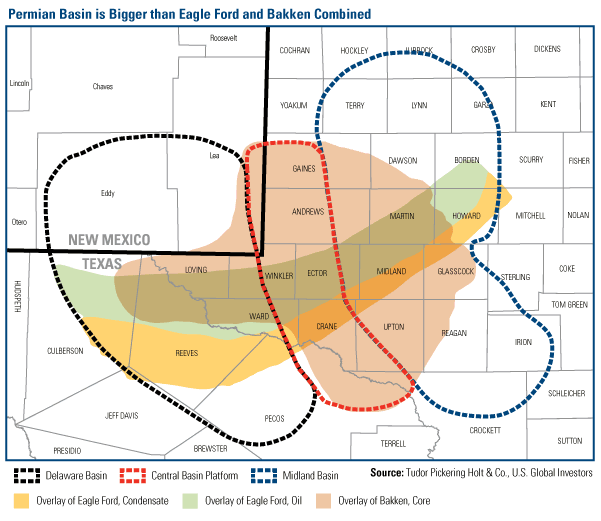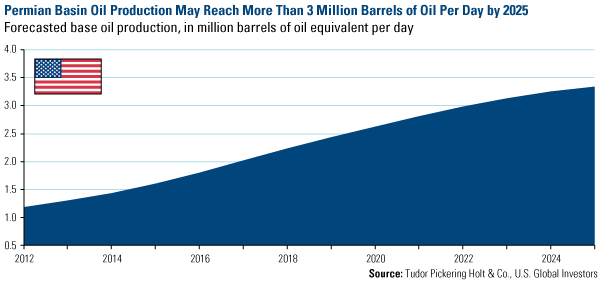An American Energy Revolution
Commodities / Energy Resources Sep 04, 2013 - 05:43 AM GMTBy: Frank_Holmes
 In Texas these days, there’s a feeling of absolute and unwavering confidence in the concept of an American energy revolution. From the depths of reserves to the richness of the energy, an incredible transformation is taking place.
In Texas these days, there’s a feeling of absolute and unwavering confidence in the concept of an American energy revolution. From the depths of reserves to the richness of the energy, an incredible transformation is taking place.
We’ve been talking about the significant impact of the U.S.’s oil production for a while now, but the buzz about shale oil and gas is only getting louder. At Morgan Stanley’s energy forum in Houston in August, Director of Research John Derrick and Portfolio Manager Evan Smith said shale was the prevailing topic.
One area that’s driving this game-changing trend is located only hours from our headquarters. It’s the Permian Basin located in western Texas and southeastern New Mexico, covering an enormous area. Three component parts make up the Permian: the western Delaware, Central Basin and eastern Midland. If you overlay the Eagle Ford and Bakken basin areas over the Permian, you can see that both the Bakken and the Eagle Ford shale formations easily fit inside.

The area isn’t new to the oil industry, as companies have been drilling in the Permian area for almost a century. Back in the 1970s, oil production reached 2 million barrels per day, but fell to 800,000 barrels per day in 2007. It wasn’t because the oil wells had dried up but companies couldn’t get at the resource. But now since the introduction of shale technology, oil production began increasing once more to 1.2 million barrels per day by 2012.
And as more data is released, the more convinced we are that this incredible growth will continue. According to Tudor Pickering Holt & Co., by 2025, oil production is projected to more than double to more than 3 million barrels per day. That’s about as much oil that is produced these days by Kuwait, the third largest oil producer in OPEC.

Natural gas in the Permian Basin is also estimated to substantially increase, growing from about 4.3 million cubic feet per day to more than 7 million cubic feet per day.
When it comes to investment plays, “the Permian is red hot right now,” says Global Hunter Securities. The research firm finds that, on a year-to-date basis, if you invested in the “pure-play” companies, including Concho Resources (CXO), Diamondback Energy (FANG) and Pioneer Natural Resources (PXD), that have a resource base in the Permian area, your portfolio would be up an incredible 39 percent.
By comparison, over the same timeframe, the SPDR S&P Oil & Gas Exploration & Production ETF (XOP) increased only 15 percent. The S&P 500 Index, which has had a great run so far, rose 16 percent.
Pioneer has been a long-term holding in the Global Resources Fund (PSPFX), and has benefited the fund with its handsome return of about 60 percent so far this year. We continue to be bullish on the company due to its substantial presence in the Permian. Pioneer has a net resource base of about 7 billion barrels of oil equivalent across more than 40,000 drilling locations in the Permian, according to Global Hunter. This enormous resource base translates to decades of drilling ahead.
Here in San Antonio, we’ve personally witnessed several economic benefits that have positive repercussions for the entire U.S. Locally, there’s been a rapid monetization of energy assets. Businesses have been building incredible expertise and creating a growing number of high-paying jobs. For the rest of the country, the effects of cheaper gas and readily available energy create enormous potential for a more competitive United States of America.
We’re seeing savvy investors already taking advantage of the nation’s incredible energy shift. You might not want to miss out. One solution that aims for better growth potential and lower volatility is the Global Resources Fund, which takes a balanced approach to the energy and materials sectors.
Evan Smith contributed to this commentary.
Want to see more on commodities or emerging markets? Provide us with your email address and you’ll receive a note every time Frank Holmes updates his blog. You can also follow U.S. Global on Twitter or Facebook.
By Frank Holmes
CEO and Chief Investment Officer
U.S. Global Investors
U.S. Global Investors, Inc. is an investment management firm specializing in gold, natural resources, emerging markets and global infrastructure opportunities around the world. The company, headquartered in San Antonio, Texas, manages 13 no-load mutual funds in the U.S. Global Investors fund family, as well as funds for international clients.
All opinions expressed and data provided are subject to change without notice. Some of these opinions may not be appropriate to every investor.Standard deviation is a measure of the dispersion of a set of data from its mean. The more spread apart the data, the higher the deviation. Standard deviation is also known as historical volatility. All opinions expressed and data provided are subject to change without notice. Some of these opinions may not be appropriate to every investor. The S&P 500 Stock Index is a widely recognized capitalization-weighted index of 500 common stock prices in U.S. companies. The NYSE Arca Gold BUGS (Basket of Unhedged Gold Stocks) Index (HUI) is a modified equal dollar weighted index of companies involved in gold mining. The HUI Index was designed to provide significant exposure to near term movements in gold prices by including companies that do not hedge their gold production beyond 1.5 years. The MSCI Emerging Markets Index is a free float-adjusted market capitalization index that is designed to measure equity market performance in the global emerging markets. The U.S. Trade Weighted Dollar Index provides a general indication of the international value of the U.S. dollar.
Frank Holmes Archive |
© 2005-2022 http://www.MarketOracle.co.uk - The Market Oracle is a FREE Daily Financial Markets Analysis & Forecasting online publication.



